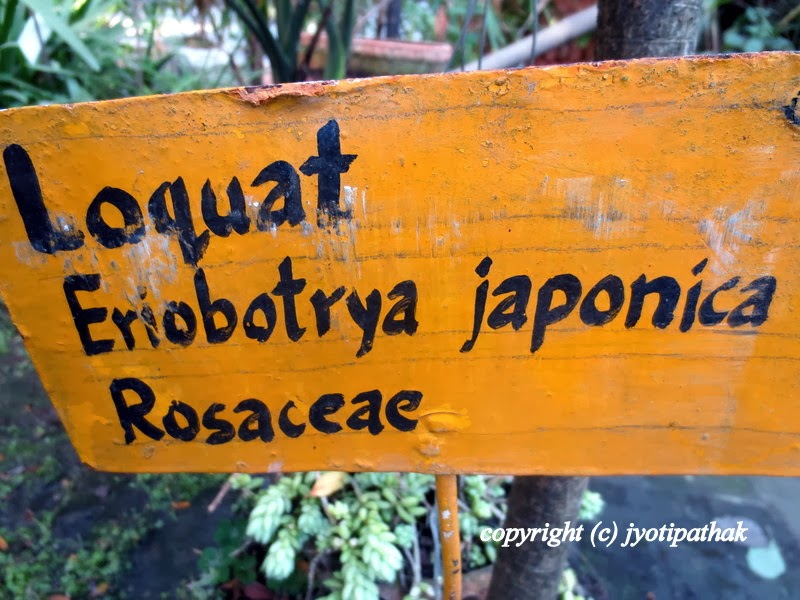There is nothing like eating fully ripe, sweet and fragrant
Loquat - लौकाट fruit of Nepal
Loquat - लौकाट fruit of Nepal
Anyone who has been reading my blog for a while will know that I have been trying to introduce Nepal's unique vegetables and fruits, whenever I get hold of it – listed below are the link of my previous blog that you probably have gone through. They are Balsam Apple (barela - बरेला), Fiddlehead Fern (neuro - नीयूरो), Bauhinia (koiralo ko phool - कोइरालो), Pumpkin Shoots (pharsi ko munta - फर्सी को मुन्टा), Taro (karkalo-gaava-pidhaalu - कर्कलो-गाभा-पिँडालु), Himalayan Wild Fruit - (kaaphal - काफल), Tree Tomato (tyammatar - ट्यामटर), Ash Gourd (kubhindo - कुभिन्डो), and Banana Blossom (kera ko bungo - केराको बुङ्गो).
Today I want to share with you an attractive evergreen fruit tree and its fruit, we call it "Nepal Loquat" (लौकाट). In scientific journals, Nepal loquat is called Eribotrya eliptica. The Wikipedia describes the fruit as Eriobotrya japonica, a species of flowering plant in the family Rosaceae, native to south-central China. Some of the common names of loquat are Japanese plum, Chinese plum, LoGuat and Maltese plum.
"Loquats are unusual among fruit trees in that the flowers appear in the autumn or early winter, and the fruits are ripe in late winter or early spring. The flowers are 1in in diameter, white, with five petals, and produced in stiff panicles of three to ten flowers. The flowers have a sweet, heady aroma that can be smelled from a distance."
"Loquat fruits, growing in clusters, are oval, rounded or pear-shaped, with a smooth or downy, yellow or orange, sometimes red-blushed skin. The succulent, tangy flesh is white, yellow or orange and sweet to sub-acid or acid, depending on the cultivar."
"Each fruit contains from one to ten ovules, with three to five being most common. A variable number of the ovules mature into large brown seeds. The skin, though thin, can be peeled off manually if the fruit is ripe.The fruits are the sweetest when soft and orange. The flavor is a mix of peach, citrus and mild mango".....continue reading here.
 |
| ...hand-picking loquot fruits from our own tree |
I have occasionally seen loquat fruits (in small quantities) for sale at local Kathmandu markets, carefully hand-picked and brought by villagers. The fruits bruise so easily and begin to brown immediately after picking up, that makes this fruit travel unfriendly. Many Nepalese who live in the city are unfamiliar with loquat fruits. My husband who was born and brought up in Kathmandu says that he has never eaten or heard of this fruit, whereas it is growing abundantly in many backyard home garden throughout the country.
Loquats bring me back to my childhood days in Kathmandu. I fondly reminisce eating these delicious golden yellow fruits straight off the tree from my grandfather's garden in Kathmandu. His backyard garden had two huge loquat trees and every year, it yielded a big harvest. Generally the fruits were allowed to ripen on the tree to golden-yellow and the juicy and fragrant fruits were carefully hand-picked from the lower branches before the birds starts feasting the fruit. Some adventurous neighborhood kids would throw stone at the fruits in the upper branches and wait for the loquat to fall. They would enjoy the fully over-ripped fruits and some of them even ate the sour and fuzzy green fruits. The unpicked fruits from the unreachable branches would over-ripe, the color would changes into orange and fall from the tree to perish. The fruit bruise very easily and do not store well, so once picked, my grandmother and her helper would make delicious fruit leather out of it.
 |
| Picture of unripe fruits growing in clusters - photo taken at my mother's farm house in Gitanagar, Chitwan District at the Terai zone of Nepal |
 |
| Each fruits contains shining large brown seeds (3-5). The seeds are inedible. |
 |
| ...Spotting loquat tree fruit plant at Nepali Nursery, mostly trees are sold as seedlings |
 |
| While researching for the botanical name of the Loquat tree in the Google search, I found a book named, "Don't let the Goats Eat the Loquat Trees" by an American Surgeon, Thomas Hall. There are many good reviews of the book, one reviewer, Dani Moore writes, "What a fascinating peek inside the life of an American Surgeon in Nepal. I always really get enthused by learning about another life from the inside, but I found this especially enjoyable"....... please click here to read more in good-reads. I have not read the book yet, but if I get hold of it, I would like to read it. |
 |
| If you have any more information on loquat fruits and would like to share, please post them in the comments section of this blog. I am always looking for more input. Thank you. |



